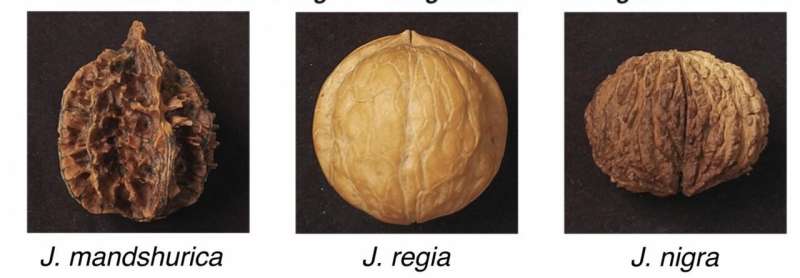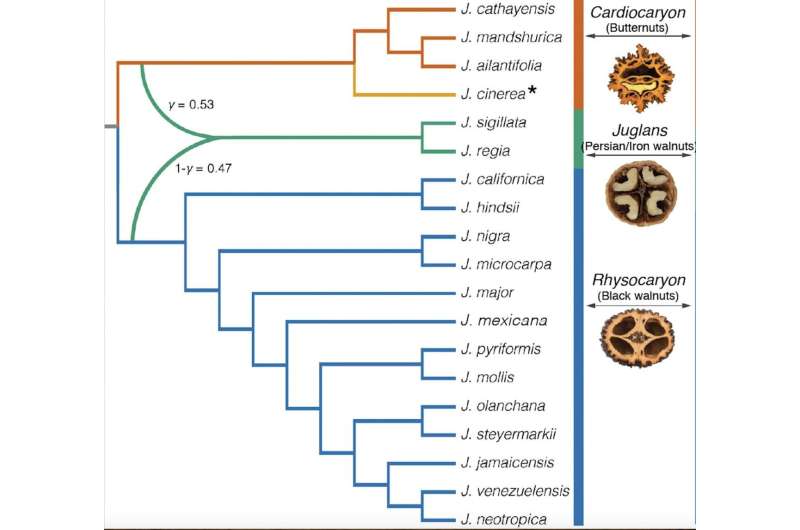Scientists crack origin of the Persian walnut

Prized worldwide for its high-quality wood and rich flavor of delicious nuts, the Persian walnut (Juglans regia) is an important economic crop. The Persian walnut is one of 22 species in the genus Juglans, which includes black and white walnuts and butternuts, grown across Europe, the Americas and Asia.
China leads world production, followed by California, Turkey and Iran. But until now, the evolution of walnuts has been unknown. Walnuts have a rich fossil record, which suggest an origin of walnuts and initial divergence into black walnuts and butternuts (white walnuts) in North America, some 35-45 million years ago. With this high age, both walnut lineages would have had ample opportunity to migrate into the Old World via the Bering and North Atlantic land bridges, yet only butternuts have been detected in the fossil records of Europe and Asia, and no ancient fossils of the Persian walnut are known.
Using genomic data analyzed with phylogenetic and population genetic approaches, researchers have now cracked this mystery, showing that the Persian walnut is the result of hybridization between two long-extinct species around 3.45 million years ago.
Past analyses by the team based on some 2900 single-copy nuclear genes from 19 species of walnuts were unable to sort out the relationships between North American, Asian, and Persian walnut species. However, they excluded incomplete lineage sorting as the cause of the phylogenetic uncertainty. "This led us to speculate that ancient hybridization might be involved in the origin of the Persian walnut and the American butternut," said Da-Yong Zhang, a population geneticist who is one of the senior authors.

To test their hybridization hypothesis, rather than look at individual genes, this time, they used whole-genome sequencing from 80 individual trees that represented 19 of the 22 species of Juglans.
"We applied a battery of genome-wide methods for hybridization detection and to test speciation models to infer the time of origin of the Persian walnut," said the Wei-Ning Bai, another senior author. "In the end, we characterized the genetic composition of the genomes of not only the Persian walnut, but also the Iron walnut, J. sigillata, and the American butternut, J. cinerea." The authors paint a picture, based on walnut fruit fossils and their genomic evidence, that walnuts "by the late Oligocene must have expanded from America to Europe and then spread to Asia and further expanded into Europe, where the black walnut and butternut lineages came into contact and hybridized some 3.45 Ma ago. While walnuts diversified in Asia and the New World, they were lost from Europe during the Pleistocene climate oscillations, with eventually only the newly formed hybrid lineage that gave rise to J. regia surviving."
"All of our genome-wide analyses converged to provide unambiguous evidence of hybridization at the roots of both the American butternut (J. cinerea) and the Persian walnut (J. regia/J. sigillata)," said the authors. "Our results further resolve the controversy concerning the origin of the American butternut, J. cinerea, which turns out to result from massive nuclear gene introgression involving an American black walnut through pollen swamping by an immigrating Asian butternut."
"The genomic mosaicism of both the Persian walnut (incl. J. sigillata) and the American butternut J. cinerea provides evidence for the importance of hybridization throughout the evolution of walnuts," said the authors.
More information: Bo-Wen Zhang et al, Phylogenomics reveals an ancient hybrid origin of the Persian walnut, Molecular Biology and Evolution (2019). DOI: 10.1093/molbev/msz112
Journal information: Molecular Biology and Evolution
Provided by Oxford University Press





















